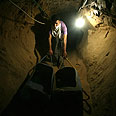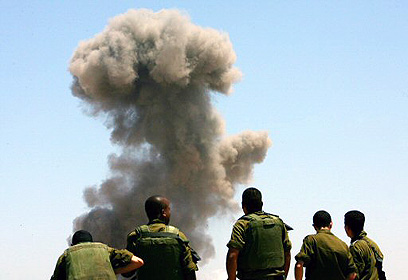
The story of what followed is well-known. After he fled to Egypt, Mabhouh emerged in Damascus. There, he earned the title of "the daring fighter who escaped the Israelis,” became one of the biggest weapon smugglers into Gaza. The arms and explosives he transferred to the Strip were used in countless terrorist attacks, and his hands continued to be covered in Israeli blood even thousands of kilometers away from Gaza. Mabhouh was assassinated last January, in a Dubai hit that made headlines worldwide. Twenty-one murderous years had passed since that night he fled Gaza.
After his mysterious escape, the Shin Bet security services launched an inquiry Mabhouh’s success in getting out from right under the soldiers' noses. The conclusion was that he used a smuggling tunnel into Egypt.
At this point, the defense establishment understood that another battle front was emerging against Israel – in addition to the aerial, ground and maritime wars, a new underground war was taking shape in the Strip. This raised concerns – which later materialized – that the tunnels could be used not only to enable terrorists to escape, but could also be utilized for the smuggling of weapons, the launch of attacks, and for kidnappings. All these concerns were discussed 17 years before Gilad Shalit was kidnapped via a tunnel.

Palestinian tunnel (Photo: Reuters)
It was obvious that something had to be done – the question was what? Finally, someone suggested that the defense establishment seek the assistance of the Geophysical Institute. The State-run research institute specializes in oil exploration and employs scientists with expertise in mapping out underground spaces. Why shouldn't all this knowledge be used to uncover Hamas terror tunnels as well?
The Geophysical Institute got on board. The result was the development of two highly efficient systems that were ready for use for many years now. In fact, they could have been used back in 2001, long before Shalit was kidnapped.
A Yedioth Ahronoth investigation revealed that, for unclear reasons, the defense establishment decided to try out other technologies instead. Tens of millions were invested in these systems, but they all proved to be failures. Now, Defense Ministry sources also admit to this.
Security chiefs warned
More than 20 years after the tunnels were identified as a clear and immediate threat, and despite Israeli technology that has been in existence for many years now, the tunnels continue to pose a threat. IDF posts and Israeli communities in the Gaza vicinity (and potentially communities adjacent to the separation fence), as well as towns on the Lebanon border are completely vulnerable to attacks or kidnappings via tunnels, and the defense establishment has no effective means to fight them.
If such a kidnapping takes place, heaven forbid, it will be impossible to claim before then next inquiry commission that "we didn't know" or that "there was nothing we could have done". The commission would simply have to open the Defense Ministry and Southern Command archives and take a peek at the protocol of an internal meeting from January.
In the meeting, commander of the Engineering Southern Command, Colonel Ilan Sabag, warned: "The Southern Command has knowledge of the existence of Hamas tunnels penetrating into our territory. The Southern Command believes these tunnels are meant to be used in the kidnapping of soldiers when the time is right. The Southern Command believes that the timing and the use of the tunnels by Hamas will be defined in accordance with considerations related to the Shalit deal… the Southern Command finds it difficult to efficiently locate the tunnels with the means available to it."
Sources at the Defense Ministry's arms development office admitted in a talk with Yedioth Ahronoth that the systems they recommended have proven to be total failures. In short, the defense establishment knows about the tunnels' existence and it knows that the existing means of detection are inefficient. All cards are on the table, except for the solution.

Are troops vulnerable to tunnel attack? (Photo: Tsafrir Abayov)
Colonel (res.) Yossi Langotsky, a leading geologist, was appointed as the chief of staff's voluntary consultant on tunnel affairs in 2004, when the number of Israelis killed as a result of terror tunnels stood at 14. When Langotsky entered the post, he was faced with a difficult reality: Proven detection means exist, but they remain on paper.
For five years now he has been bombarding defense establishment heads with letters and reports; none of them will be able to say, "I didn't know."
"Before a disaster happens, I am warning you that the kidnapping, heaven forbid, of a number of soldiers, and their transfer as hostages into enemy territory… along our border with the Gaza Strip… is an option with unfortunately very high chances of being realized," Langotsky wrote to the defense minister, IDF chief of staff and Southern Command head some months ago. And he makes no effort to conceal the cause of the ongoing threat: "The defense establishment and the IDF did not get their act in order, did not prepare and did not equip themselves properly; this includes the systems that are 'on the shelf' along the relevant borders."
Before diving into Langotsky's frightening scenarios, now is the time to understand the scope and dimensions of the tunnel threat.
‘The seismic fence’
During the 21 years since Mabhouh's escape, several Gaza clans have developed expertise in the field of tunnel digging. Despite having relatively limited technical means, the tunnels being dug keep getting deeper. In 1990, when the Defense Ministry first contacted the Geophysical Institute, a tunnel survey was carried out near the Philadelphi route, which showed that the average depth of a smuggling tunnel ranged from 10-15 meters. Today, the average depth of a Gaza tunnel stands at some 20 meters, and it is believed that the deeper tunnels reach a depth of 30 meters. Meanwhile, the underground barrier constructed by Egypt on the Philadelphi route is only 25 meters deep, meaning the tunnel builders will just dig under it.
The problem with the "tunnel wars" is not destroying them, which is a relatively simple task. The problem has to do with uncovering them. As was proven, traditional intelligence is insufficient. In June 2006, Israel possessed intelligence that terror groups planned to kidnap a soldier in Gaza. This did not stop the excavation of the tunnel through which the cell that kidnapped Shalit entered Israel, and returned with him to the Strip. This is where the Geophysical Institute enters the picture.
In the early 1990s, the Institute began searching for ways to help the IDF build permanent, reliable systems for detecting tunnels. In order to tackle the problem of "noisy tunnels", meaning tunnels that contained movement such as digging or the transfer of equipment or people, the institute developed a system called the "underground seismic fence." This system is built on a network of electronic sensors called geophones, which are used around the world for detecting oil.
The seismic fence was developed during the 1990s, when the dangers of terrorist bombers and abductors infiltrating Israel were clear. Once the system was developed, it was tested at Kerem Shalom – the same area where Shalit was kidnapped several years later. The Institute built a tunnel at its own cost, and the seismic fence was activated.
The experiment was a success: The Institute's researchers used several different tools in the tunnel, and the system was able to detect the digging path accurately at any depth, and in a radius of a few dozen meters. In other words, had such system been in place, the IDF would have received a warning of several meters, which equal several days of digging, before the tunnel would have reached the Israeli side. It's easy to think what would have happened had Shalit's commanders received a few days warning in the area where the tunnel was being dug.
14 dead soldiers
In 2001, the Geophysical Institute informed the Defense Ministry that the system was ready. But instead of celebrating the success, the Institute suddenly learned that the Defense Ministry was examining other options.
In August, 2001, Dr. Yair Rotstein, the Institute's director at the time, wrote to then-Defense Minister Binyamin Ben-Eliezer, expressing his concern: "The ongoing digging of tunnels from the Palestinians Authority's territory into Egypt… is a painful matter that the defense establishment has been trying to find a solution to for over 10 years… We have reached the conclusion that a seismic fence should be built along the Philadelphi Route… in contrast to our recommendations, the defense establishment has chosen other means."
Rotstein urged Ben-Eliezer to appoint a body to work with the Institute on the matter, but no progress was made. A few letters and meeting later, there was still no seismic fence, and in 2004, the Defense Ministry's arms development office informed the Institute that a private company had presented a much better, more accurate system.
In December 2004, the worst happened. A booby-trapped tunnel exploded near a Rafah checkpoint and left five soldiers dead. Six others were wounded. Days after the incident, the director general of the Ministry of National Infrastructures, which the Geophysical Institute is a branch of, wrote to the director general of the Defense Ministry: "I understand (the Geophysical Institute) has the technological abilities to counter the problem, in an immediate timeframe, using active and passive means. This is available equipment that can be acquired and activated immediately."

Tunnel blown up by IDF (Photo: Reuters)
In response, the Defense Ministry said: "The experiment that was proposed by the Geophysical Institute was carried out while examining three companies that offered similar active technologies. The test's results showed that the performance of the system presented by the Institute was insufficient compared to the two other companies, and therefore it has been decided to continue working with these companies."
Following the Rafah explosion, and after the tunnels had taken the lives of a total of 14 IDF solders, then IDF Chief of Staff Moshe Ya'alon appointed Langotsky as his advisor on tunnel affairs. Langotsky said that from the moment he took the job, he found that many reports were hidden from him, and fallacious reports were issued instead. He said that in a December 2004 meeting with Ya'alon, the detectors which the Defense Ministry claimed were superior to the Geophysical Institute's were reported to be "completely unfit" after months of tests.
Ministry admits complete failure
When we presented the claims the Institute’s and Langotsky’s claims to the Defense Ministry, its spokesman called a special meeting. Two officers in charge of tunnel affairs attended the meeting – a colonel and a lieutenant colonel who requested their names not be published. They presented a full set of efforts the Defense Ministry has invested in the tunnel matter in recent years. The two piled large folders and files full of papers on the desk."We can't show you because they are classified, but we wanted you to understand just how much had been done in the matter over the years," they said. Nonetheless, the two did admit that the matter was considered marginal until around 2002, and rejected the claim that they were dealing with the issue for 20 years. "We have been dealing with it seriously for only eight or nine years, and that was before my time and I cannot respond about what happened then," the colonel said.
"This is a very complex matter," one officer added. "The defense establishment has received numerous offers from many different bodies; most of them lack any understanding of the matter. But we take each proposal we receive seriously." The two presented a long table listing tunnel detection system proposals, which also included some rather bizarre options, such as detecting tunnels using meditation, séances, and more.
But there were some more serious suggestions, such as the Geophysical Institute's system. The Defense Ministry's arms development office ultimately decided to go with a private company's system, which operates similarly to the seismic fence. In this week's meeting, Defense Ministry sources admitted for the first time that this system was a complete failure. The tens of millions that were invested in it went down the drain.
When we asked what caused the failure, they pinned the blame on other Ministry and IDF bodies, which failed to identify the system's serious engineering problems. When asked why this system was chosen over that of the Geophysical Institute, they said, "The military's demand was for a system that would offer completely accurate detection of the tunnel path, at higher resolution of that offered by the Geophysical Institute…the private company’s system met these demands during viability tests.”
However, there are some good news: The officers said that the army has decided to go back to the drawing board and reexamine all the systems that had been offered in the past, including the one designed by the Geophysical Institute. Simultaneously, the Defense Ministry is in contact with another state which is currently contending with a similar problem of smuggling through border tunnels. There too, a comprehensive solution had not yet been found. “Such solution may not exist,” an army official said.
Northern threat worse
Langotsky’s recommendations had also been submitted to former IDF Chief of Staff Dan Halutz. Langotsky stressed that an emergency plan that would include the immediate deployment of Geophysical Institute systems as well as “the establishment of a (compact) administration on the issue of tunnels that would regularly coordinate the efforts.” He also recommended that the administration cooperate with a team of scientists and technological experts that would include civilians possessing dozens of years of experience in the field. He included a list of renowned experts that said they would agree to voluntarily join the project.
Army Chief Halutz responded: “Yossi Shalom. Got it. Read it. Impressive. Will be handled accordingly. We shall talk soon. Halutz.” Langotsky is still waiting.
Meanwhile, a Yedioth Ahronoth inquiry showed that a similar and possibly worse situation prevails on Israel’s northern border. Hezbollah has already proven impressive tunnel-digging capabilities within Lebanon. Intelligence information points to Hezbollah intentions and plans to target IDF outposts or infiltrate Israel in case of a flare-up.

IDF troops on Lebanon border (Photo: Avihu Shapira)
The latest attempts to do something about it were undertaken relatively recently. In January 20 of this year, Langotsky wrote the Southern Command chief, army chief, defense minister, and later the prime minister too and warned yet again about the threat of abduction via tunnels. “This warning is based on my understanding of the lessons drawn by our enemies in respect to the ‘Shalit effect’ and the temptation for a ‘mega-Shalit’ operation.”
For now, Langotsky continues to sound the alarm. In February, he managed to convince Southern Command officers to attend a demonstration at the Geophysical Institute. “According to assessments of Geophysical Institute experts, this equipment may serve as an ‘underground seismic fence,’ as they’ve been telling and writing the defense establishment time and again over for more than a decade now.”
In the meeting, Southern Command officers said that yet another test must be held as soon as possible in order to prove the system’s effectiveness. But as happened before, weeks have passed and nothing has been done.
“Several phone messages left by me were not returned at all,” Langotsky angrily wrote the Southern command. “Three months have passed since we met, two months have passed since we handed over the test plan you asked for, yet nobody is answering!!!”
- Follow Ynetnews on Facebook















